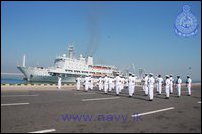 2ND LEAD (Update)
2ND LEAD (Update)
Rajapaksa pondering of revising Wickramasinghe's 99-year port-lease to China
[TamilNet, Tuesday, 06 November 2018, 22:22 GMT]
Mahinda Rajapaksa has spoken to Chinese officials about ‘revising the terms’ of the Hambantota port lease, a report by the Associated Press said on Monday. The AP was citing Kehaliya Rambukwella, the spokesman of Rajapaksa-led SL government in Colombo. Mr Rajapkasa lost his executive presidency in January 2015, three months after a Chinese warship and a submarine docked Colombo in October 2014. Now, Wickramasinghe has learnt the same lesson after the infamous 99-year port lease to China, commented Tamil political observers in Jaffna.
On 31 October 2014, a Chinese warship Chang Xing Dao and a submarine Changzheng-2 docked at Colombo Port. The Indian defence establishment interpreted it as a hostile act that violated Indo-Lanka agreement, which barred the unitary State in Colombo from allowing its port or territory to be made available by any country in a manner prejudicial to India's interests.
Mangala Samaraweera, who became the SL Foreign Minister after the regime change in January 2015, was quick to remind China during a visit to Beijing that the new government would not be allowing foreign submarines to use the Island's ports.

Chinese PLA Naval Ship "865" at the Port of Colombo on 26th February 2016 [Photo courtesy: SL Navy]

Chinese midshipmen aboard the PLA Navy's training ship Qi Jiguang wave while leaving the Colombo Harbour after a four-day on Nov 14, 2017 [Photo courtesy: eng.chinamil.com.cn]
![Chinese navy ship Hai Yangdao at Colombo on October 04, 2018 [Photo courtesy: SL Navy]](/img/publish/2018/11/Chinese_naval_vessel_Col_2018_October_117784_200.jpg)
Chinese navy ship Hai Yangdao at Colombo on October 04, 2018 [Photo courtesy: SL Navy]
Although the UNP government refused docking of a Chinese submarine in May 2017, the Chinese naval vessels continued to call at Colombo port at least 2-3 times every year also during the UNP government. The latest Chinese naval to dock at Colombo in October 2018 was ‘Hai Yangdao’.
Back in January 2015, Rajapaksa responded to Indian reactions in South China Morning Post: "Whenever Chinese submarines come to this part of the world, they always inform India. The Chinese president was here, so the subs were here. Find out how many Indian submarines and warships came to our waters when the Indian prime minister came for the SAARC South Asian Association for Regional Cooperation) summit [in 2008]."
Mr Rajapaksa seems to have learnt specific lessons the hard way now, and he has managed to convince sections of the current Indian defence establishment, the observers in Jaffna further said.
This time, it was an investigative feature, which appeared in the New York Times on 25 June, that had set the scene for current controversy. It was titled “How China Got Sri Lanka to Cough Up a Port.”
“Months of interviews with Sri Lankan, Indian, Chinese and Western officials and analysis of documents and agreements stemming from the port project present a stark illustration of how China and the companies under its control ensured their interests in a small country hungry for financing,” the New York Times feature has stated.
Revealing details of how China was ‘engaging’ with Rajapaksa siblings, including the transfer of money for them during the election campaign in 2015, the article also exposed the inability of Ranil Wickramasinghe's government.
Following the feature, regardless of its intentions, SL Prime Minister Wickramasinghe was forced into a defensive position.
“I state with responsibility that our government was never pressurised by the Chinese government to hand over the port to them. We had many options, and we could have followed whatever we wanted. They only requested us to initially call for proposals from Chinese companies. In response, we called for open tenders and the most profitable from those we received was from China Harbour Merchant Company,” Wickramasinghe told the SL Parliament on 05 July.
Some excerpts from the New York Times feature follow:
“The new government was eager to reorient Sri Lanka toward India, Japan and the West. But officials soon realized that no other country could fill the financial or economic space that China held in Sri Lanka.”
“When the new Sri Lankan government came to office, it sought assurances that the port would never again welcome Chinese submarines — of particular concern because they are difficult to detect and often used for intelligence gathering. But Sri Lankan officials had little real control.”
“[A]s Sri Lankan officials became desperate to get the debt off their books in recent years, the Chinese demands centered on handing over equity in the port rather than allowing any easing of terms.”
“When the agreement was initially negotiated, it left open whether the port and surrounding land could be used by the Chinese military, which Indian officials asked the Sri Lankan government to explicitly forbid. The final agreement bars foreign countries from using the port for military purposes unless granted permission by the government in Colombo.”
External Links:
Chronology:









![Chinese navy ship Hai Yangdao at Colombo on October 04, 2018 [Photo courtesy: SL Navy]](/img/publish/2018/11/Chinese_naval_vessel_Col_2018_October_117784_200.jpg)